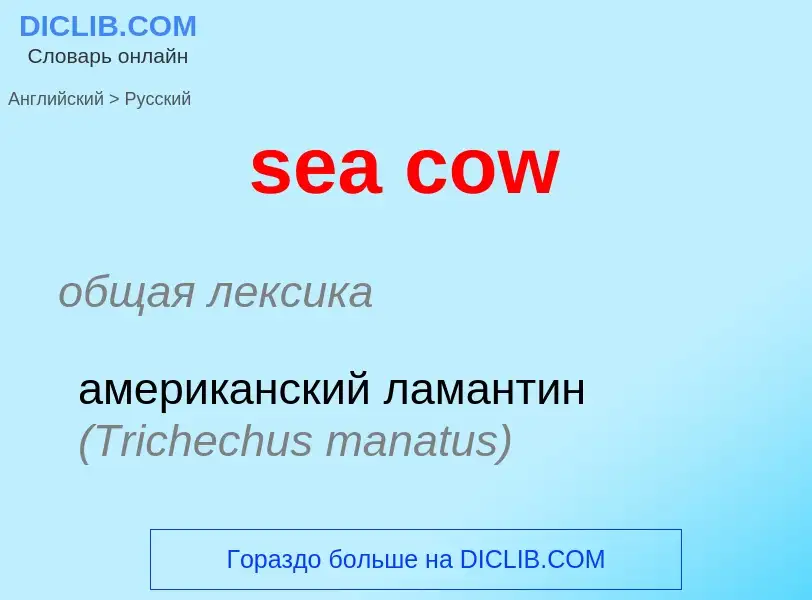Перевод и анализ слов искусственным интеллектом ChatGPT
На этой странице Вы можете получить подробный анализ слова или словосочетания, произведенный с помощью лучшей на сегодняшний день технологии искусственного интеллекта:
- как употребляется слово
- частота употребления
- используется оно чаще в устной или письменной речи
- варианты перевода слова
- примеры употребления (несколько фраз с переводом)
- этимология
sea cow - перевод на русский
общая лексика
американский ламантин (Trichechus manatus)
морж (Odobenus rosmarus)
сирены (Sirenia)
['si:kau]
существительное
зоология
ламантин (Trichechus latirostris)
сирена (Sirenia gen.)
морж
ламантин
дюгонь
гиппопотам
общая лексика
морская [стеллерова] корова (Hydrodamalis gigas)
['kaupæt]
существительное
эвфемизм
коровья лепёшка (кучка навоза)
[ri'tainə]
палеонтология
гидродамал
существительное
палеонтология
гидродамал
['tʃuktʃi(:)'si:]
география
Чукотское море
Определение
2) Эгейское море
Википедия

The Sirenia (), commonly referred to as sea cows or sirenians, are an order of fully aquatic, herbivorous mammals that inhabit swamps, rivers, estuaries, marine wetlands, and coastal marine waters. The extant Sirenia comprise two distinct families: Dugongidae (the dugong and the now extinct Steller's sea cow) and Trichechidae (manatees, namely the Amazonian manatee, West Indian manatee, and West African manatee) with a total of four species. The Protosirenidae (Eocene sirenians) and Prorastomidae (terrestrial sirenians) families are extinct. Sirenians are classified in the clade Paenungulata, alongside the elephants and the hyraxes, and evolved in the Eocene 50 million years ago (mya). The Dugongidae diverged from the Trichechidae in the late Eocene or early Oligocene (30–35 mya).
Sirenians grow to between 2.5 and 4 metres (8.2 and 13.1 feet) in length and 1,500 kilograms (3,300 pounds) in weight. The recently extinct Steller's sea cow was the largest known sirenian to have lived, reaching lengths of 10 metres (33 feet) and weights of 5 to 10 tonnes (5.5 to 11.0 short tons).
Sirenians have a large, fusiform body to reduce drag through the water and heavy bones that act as ballast to counteract the buoyancy of their blubber. They have a thin layer of blubber and consequently are sensitive to temperature fluctuations, which cause migrations when water temperatures dip too low. Sirenians are slow-moving, typically coasting at 8 kilometres per hour (5.0 miles per hour), but they can reach 24 kilometres per hour (15 miles per hour) in short bursts. They use their strong lips to pull out seagrasses, consuming 10–15% of their body weight per day.
While breathing, sirenians hold just their nostrils above the surface, sometimes standing on their tails to do so. They typically inhabit warm, shallow, coastal waters, or rivers. They are mainly herbivorous, but have been known to consume animals such as birds and jellyfish. Males typically mate with more than one female and may gather in leks to mate. Sirenians are K-selected, displaying parental care.
The meat, oil, bones, and skins are commercially valuable. Mortality is often caused by direct hunting by humans or other human-induced causes, such as habitat destruction, entanglement in fishing gear, and watercraft collisions. Steller's sea cow was driven to extinction due to overhunting in 1768.


 colourised.png?width=200)


.jpg?width=200)
 (Tenrec ecaudatus).jpg?width=200)










![taxa]] taxa]]](https://commons.wikimedia.org/wiki/Special:FilePath/Sirenians evolution.gif?width=200)
 (Chrysochloris asiatica).jpg?width=200)
![Rehabilitation of an [[Amazonian manatee]] calf by the [[Brazilian Institute of Environment and Renewable Natural Resources]] (IBAMA) Rehabilitation of an [[Amazonian manatee]] calf by the [[Brazilian Institute of Environment and Renewable Natural Resources]] (IBAMA)](https://commons.wikimedia.org/wiki/Special:FilePath/Trichechus inunguis.jpg?width=200)













.jpg?width=200)
![Cow dung in [[Bangladesh]] Cow dung in [[Bangladesh]]](https://commons.wikimedia.org/wiki/Special:FilePath/Cow dung fuel.jpg?width=200)








![[[Erythraean Sea]] 1838. [[Erythraean Sea]] 1838.](https://commons.wikimedia.org/wiki/Special:FilePath/Soulier, E.; Andriveau-Goujon, J. Anciens Empires Jusqua Alexandre. 1838.jpg?width=200)
![Jansson]] Map of the Indian Ocean ([[Erythraean Sea]]) Jansson]] Map of the Indian Ocean ([[Erythraean Sea]])](https://commons.wikimedia.org/wiki/Special:FilePath/1658 Jansson Map of the Indian Ocean (Erythrean Sea) in Antiquity - Geographicus - ErythraeanSea-jansson-1658.jpg?width=200)

![17th century map depicting the locations of the ''[[Periplus of the Erythraean Sea]]'' 17th century map depicting the locations of the ''[[Periplus of the Erythraean Sea]]''](https://commons.wikimedia.org/wiki/Special:FilePath/PeriplusAncientMap.jpg?width=200)
![A horizontal Malabar Coast miniature, a reprint by [[Petrus Bertius]], 1630 A horizontal Malabar Coast miniature, a reprint by [[Petrus Bertius]], 1630](https://commons.wikimedia.org/wiki/Special:FilePath/A horizontal Malabar Coast miniature, a reprint by Petrus Bertius, 1630.jpg?width=200)
![Asia. [[Sinus Persicus]] and the Mare Persicum Asia. [[Sinus Persicus]] and the Mare Persicum](https://commons.wikimedia.org/wiki/Special:FilePath/Asia in the shape of the mythical winged horse Pegasus..jpg?width=200)
![Iran and [[Makran]] Iran and [[Makran]]](https://commons.wikimedia.org/wiki/Special:FilePath/Map of persia.jpg?width=200)


![Palm]] and [[sunset]] in [[Minoo Island]], Iran. Palm]] and [[sunset]] in [[Minoo Island]], Iran.](https://commons.wikimedia.org/wiki/Special:FilePath/Nakhl-Minoo.jpg?width=200)
![[[Dugong]] mother and her offspring in shallow waters. [[Dugong]] mother and her offspring in shallow waters.](https://commons.wikimedia.org/wiki/Special:FilePath/Dugong.jpg?width=200)





![[[Defense Mapping Agency]] topographical map of the Chukchi Sea, 1973 [[Defense Mapping Agency]] topographical map of the Chukchi Sea, 1973](https://commons.wikimedia.org/wiki/Special:FilePath/Operational Navigation Chart C-8, 2nd edition.jpg?width=200)

![Tungusic]] Sea"), had been well mapped by 1792, apart from [[Sakhalin]] Tungusic]] Sea"), had been well mapped by 1792, apart from [[Sakhalin]]](https://commons.wikimedia.org/wiki/Special:FilePath/Generalkarte Russisches Reich 1792 2.jpg?width=200)


![[[Nagayevo Bay]] near [[Magadan]], [[Russia]] [[Nagayevo Bay]] near [[Magadan]], [[Russia]]](https://commons.wikimedia.org/wiki/Special:FilePath/Freezing the waters of the Sea of Okhotsk. Magadan.jpg?width=200)
![[[Shiretoko National Park]] on the Sea of Okhotsk coast of [[Hokkaido]], [[Japan]] [[Shiretoko National Park]] on the Sea of Okhotsk coast of [[Hokkaido]], [[Japan]]](https://commons.wikimedia.org/wiki/Special:FilePath/Shiretoko National Park.jpg?width=200)
